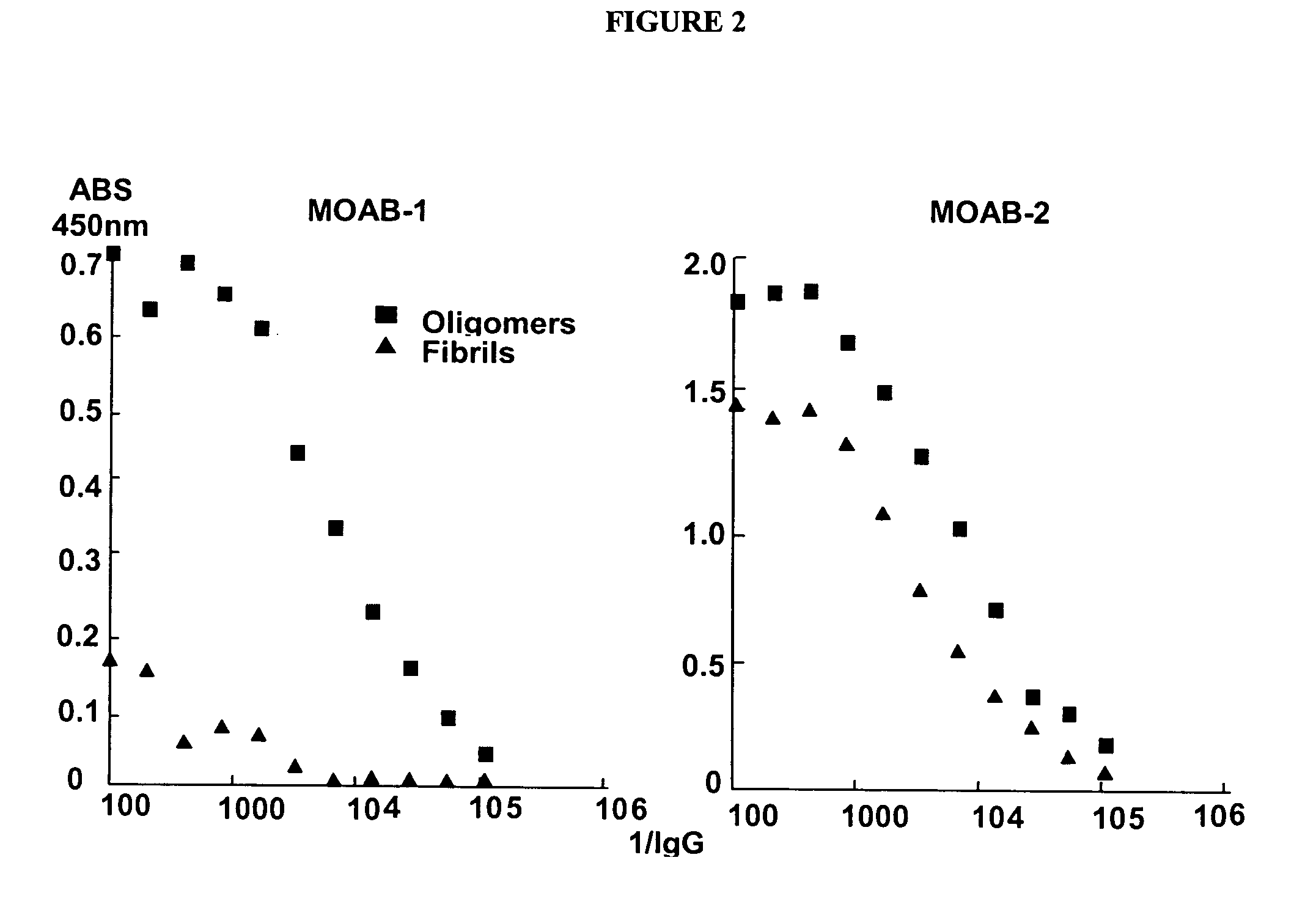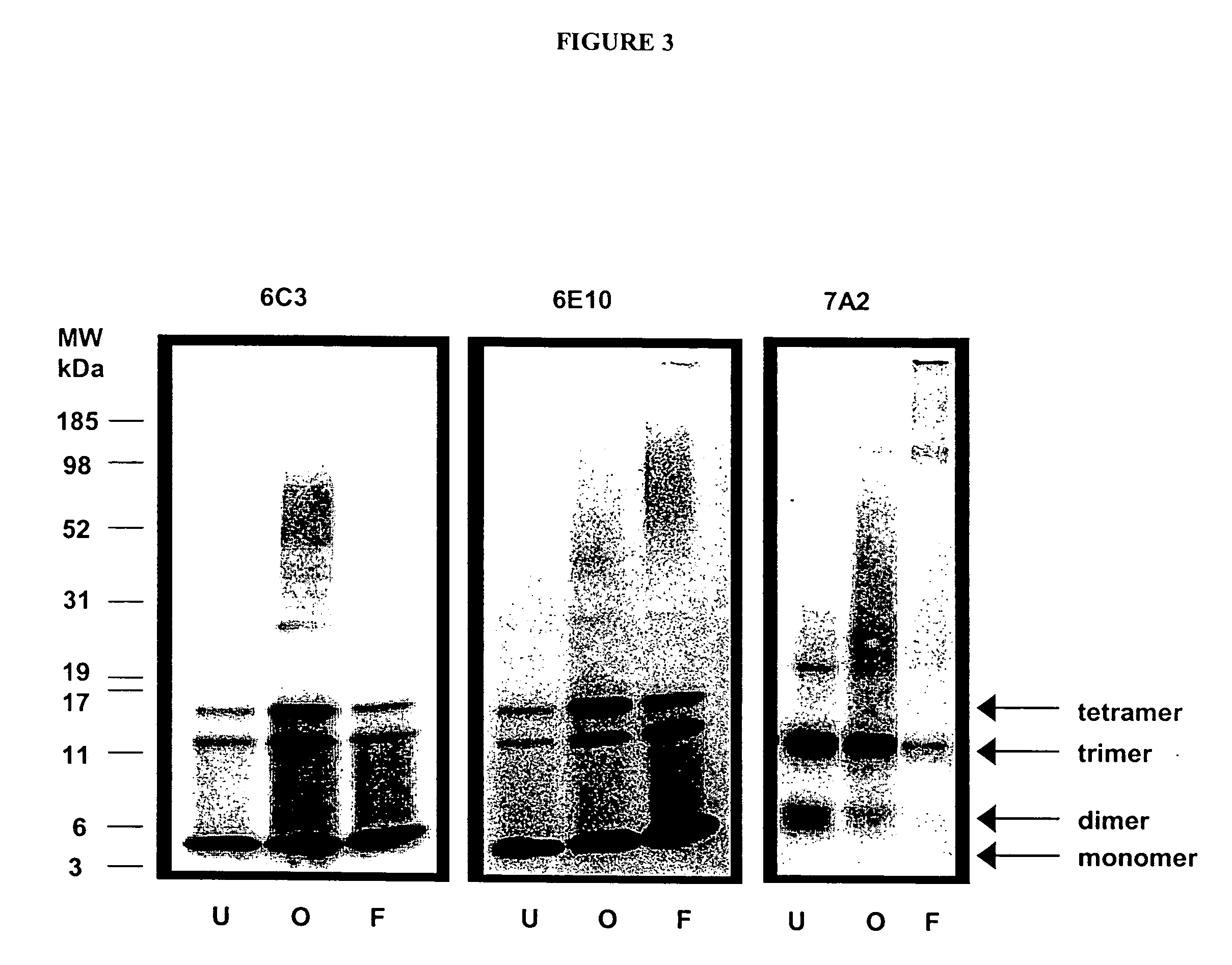Antibodies specific for toxic amyloid beta protein oligomers
an amyloid beta and anti-tumor technology, applied in the field of alzheimer's disease diagnosis, can solve the problems of reducing patient and care-giver productivity, costing approximately $100 billion each year, and ad is the third most expensive disease in the united states
- Summary
- Abstract
- Description
- Claims
- Application Information
AI Technical Summary
Benefits of technology
Problems solved by technology
Method used
Image
Examples
example 1
Materials and Methods
[0111] Generation of fibrillar or oligomeric immunogens for generation of hybridomas. Pretreated stocks of amyloid β protein stored as HFIP films are monomerized in DMSO, then aggregated in dilute acid at low salt (10 mM HCL) to produce fibrillar amyloid β protein, or, in cell culture media (phenyl-free F12, Gibco BRL) containing physiologic salt and pH levels to produce oligomeric structures. The amyloid β protein fibrils produced under the acidic conditions have diameters that measure approximately ˜4 nm in z-height and extend for several microns. Oligomers produced in cell culture media range in size from ˜2 nm in z-height.
[0112] Immunizations. Female Balb / c mice are immunized with amyloid β protein oligomers or fibrils produced as described above. The immunogens employed are suspended in Freunds Incomplete Adjuvant at a concentration of 1 μg / μl. A total of 200 μg is injected subcutaneously every 2 weeks until the serum titer of the mouse is half-maximal at...
example 2
Screening of Hybridoma Supernatants by Antigen / Antibody Blotting
[0115] In order to determine the specificity of the antibodies made by the hybridomas, supernatants of the hybridomas were screened by antigen / antibody blotting. 5 μM amyloid β protein1-42 oligomer or fibril solutions were incubated with Immobilon-P membranes at room temperature for 30 minutes. Following rinsing and blocking, hybridoma supernatant was spotted onto membrane with a 96-pin replicator.
[0116] This method identified several hybridomas making antibodies which appeared specific for oligomer amyloid β protein assemblies and not the fibrillar form (FIG. 1). Monoclonal antibodies from the hybridoma 7A2 are oligomer-specific and show little recognition of fibrils by antigen / antibody blotting. In contrast, antibodies from the hybridoma 6C3 do not demonstrate specificity for oligomers or fibrils by antigen / antibody blotting.
example 3
ELISA Titer: Oligomer-Versus Fibril Specificity for 6C3 and 7A2
[0117] Antibodies from hybridomas 7A2 and 6C3 were purified to homogeneity and further characterized in an ELISA assay. Serial dilutions of the purified antibodies were incubated with 25 ng of fibrillar or oligomeric amyloid β protein assemblies in the solid phase. 7A2 antibodies do not recognize fibrils by antigen / antibody blotting (FIG. 1). Additionally, standard ELISA shows that 7A2 antibodies display significant affinity for oligomeric assemblies while not displaying a similar affinity for fibrillar assemblies (FIG. 2). In contrast, although 6C3 does not demonstrate specificity for oligomers or fibrils by antigen / antibody blotting, standard ELISA shows 6C3 antibodies display some preference for oligomeric assemblies over that of fibrillar assemblies (FIG. 2).
PUM
| Property | Measurement | Unit |
|---|---|---|
| diameters | aaaaa | aaaaa |
| size | aaaaa | aaaaa |
| concentration | aaaaa | aaaaa |
Abstract
Description
Claims
Application Information
 Login to View More
Login to View More - R&D
- Intellectual Property
- Life Sciences
- Materials
- Tech Scout
- Unparalleled Data Quality
- Higher Quality Content
- 60% Fewer Hallucinations
Browse by: Latest US Patents, China's latest patents, Technical Efficacy Thesaurus, Application Domain, Technology Topic, Popular Technical Reports.
© 2025 PatSnap. All rights reserved.Legal|Privacy policy|Modern Slavery Act Transparency Statement|Sitemap|About US| Contact US: help@patsnap.com



